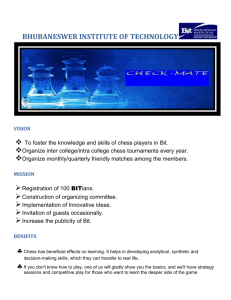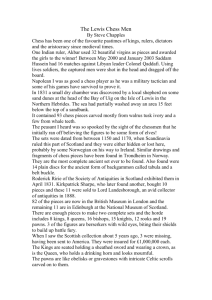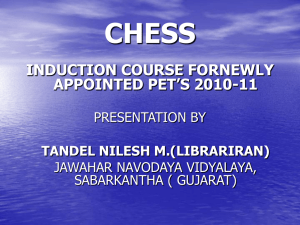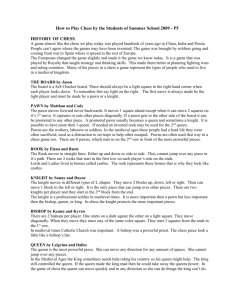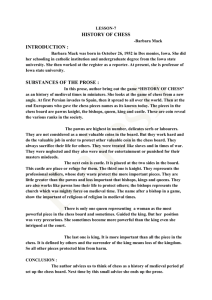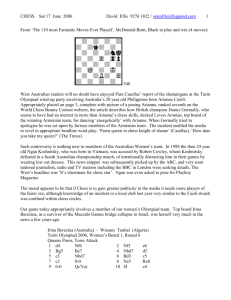Basic Opening Rules
advertisement
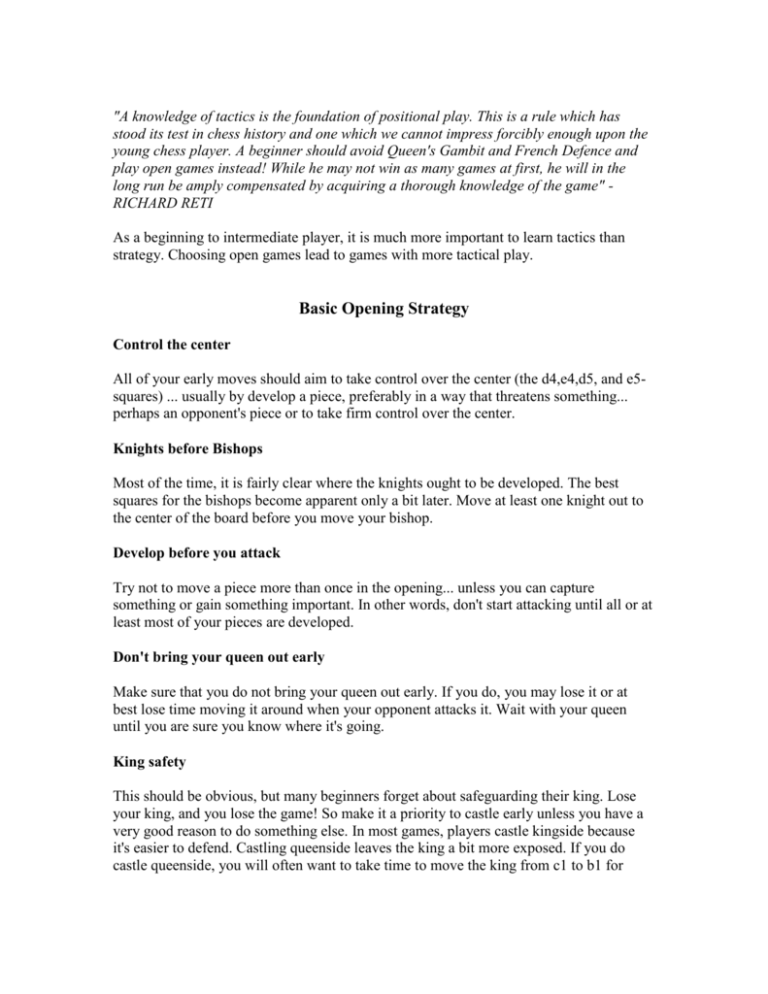
"A knowledge of tactics is the foundation of positional play. This is a rule which has stood its test in chess history and one which we cannot impress forcibly enough upon the young chess player. A beginner should avoid Queen's Gambit and French Defence and play open games instead! While he may not win as many games at first, he will in the long run be amply compensated by acquiring a thorough knowledge of the game" RICHARD RETI As a beginning to intermediate player, it is much more important to learn tactics than strategy. Choosing open games lead to games with more tactical play. Basic Opening Strategy Control the center All of your early moves should aim to take control over the center (the d4,e4,d5, and e5squares) ... usually by develop a piece, preferably in a way that threatens something... perhaps an opponent's piece or to take firm control over the center. Knights before Bishops Most of the time, it is fairly clear where the knights ought to be developed. The best squares for the bishops become apparent only a bit later. Move at least one knight out to the center of the board before you move your bishop. Develop before you attack Try not to move a piece more than once in the opening... unless you can capture something or gain something important. In other words, don't start attacking until all or at least most of your pieces are developed. Don't bring your queen out early Make sure that you do not bring your queen out early. If you do, you may lose it or at best lose time moving it around when your opponent attacks it. Wait with your queen until you are sure you know where it's going. King safety This should be obvious, but many beginners forget about safeguarding their king. Lose your king, and you lose the game! So make it a priority to castle early unless you have a very good reason to do something else. In most games, players castle kingside because it's easier to defend. Castling queenside leaves the king a bit more exposed. If you do castle queenside, you will often want to take time to move the king from c1 to b1 for added safety. Even on the kingside, it is often a good idea to make the king safer by moving it from g1 to h1. 10 rules for the opening 1. Get your pieces out into the center quickly. The opening is a race to see who can get their pieces out first while keeping at least a share of control of the center. o This is the main point to remember; all the other rules are just footnotes to this one 2. More detail on winning the race: o Move pieces not pawns, and o move them to their best squares in one move if you can, and also o try to gain time if you can by aggressive moves. 3. Move minor pieces out first, not your Q or RRs which can be attacked and lose time 4. Get a firm foothold in the center and don't give it up 5. Generally move Knights straightaway to f3/c3 or f6/c6 6. Move your king to safety at the side by castling King's-side (which also gets your Rook into play) 7. Complete your development before moving a piece twice or starting an attack 8. Keep your queen safe 9. Don't grab pawns or attack if you haven't completed development 10. What to do if there is a lead in development: o If you are ahead in development, start something going and open up lines for your better pieces o If you are behind in development, don't start anything and keep things closed until you have caught up Lasker's rules for the opening 1. Do not move any pawns in the opening of a game but the King and Queen pawns. 2. Do not move any piece twice in the opening, but put it at once on the right square. 3. Bring out your knights before developing your bishops, especially the Queen's Bishop. 4. Do not pin the adverse King Knight (ie. by Bg5) before your opponent has castled. Chess Strategy Excerpt from Chess Step by Step by Frank Marshall and J.C.H. Macbeth The intelligent reader may enquire: "Why am I supposed to study Chess Strategy, while I have only a very slender knowledge of the Chess Openings?" The reply to this question is, that learning Chess is somewhat similar to learning a language. We all know that children acquire a certain vocabulary of their native tongue before they begin to delve into the mysteries of grammar and syntax, and, as a matter of fact, a considerable proportion of people of all nationalities are content to go through life without troubling themselves to learn the laws and principles which govern their language. In Chess, knowledge of the moves and how to play under certain given conditions is equivalent to acquiring a vocabulary in a language, and the syntax may be said to be the study and analysis of the Openings, which we have therefore reserved for a later stage, by which time the student will be better equipped for the task of making himself conversant with the subtleties and beauties of the many and complex variations in the different Chess Openings. Some Opening Principles and Chess Strategies For the purpose of study and analysis, a game of Chess is divided into three phases – the Chess Opening, the Middle Game, and the End Game. The Chess Opening consists of the first six or eight moves, when both sides endeavor to develop their forces into the sphere of action where they will exercise the greatest power against the opponent’s defenses. By this time the reader will be in a position to understand the following principles with regard to the Chess Opening – principles which experience has proved cannot be deviated from with impunity. * Avoid Moving a Chess Piece Twice During the Opening is a good chess strategy. This means that when you have developed a piece, it should not be moved again until the other pieces have been developed. If a piece has been attacked, it must, of course, be moved, but this is not a violation of the rule, as the opponent in all probability has departed from principle in attacking your piece, which will ultimately prove to be advantageous to you. * It is Better Chess Strategy to Develop the Knights before Their Respective Bishops. This principle does not mean that both Knights should be developed before bringing out a Bishop, but that it is advisable to play say the King’s Knight before the King’s Bishop, and similarly on the Queen’s side. The following is an example of the consequences that may ensue by violating the foregoing principles and strategies. White Black 1.e4 e5 2.Nf3 d6 3.Bc4 Bg4 Here Black has violated the strategy principle by playing the Bishop instead of the Knight. 4.Nc3 Nc6 5.0-0 Nd4 Black has again played contrary to the principle strategy, in moving the Knight twice during the Opening. 6.Nxe5 dxe5 Best. If at his 6th move Black plays 6...Bxd1, White gives Mate in two moves: 7.Bf7+ Ke7 8.Nd5#, and Knight Mates. The move in the text leaves him a pawn minus and an inferior position. * A good chess strategy is to Develop Both Knights before the Queen’s Bishop. * A good chess strategy is Do Not Develop your Chess Pieces Exclusively on One Side. * A good chess strategy is as a Rule Do Not Play a Piece beyond Your Own Side of the Board in the Opening. This last principle means that you should not play a piece beyond its 4th square, until by development you have the other pieces ready to back up any incursions the piece may make into enemy territory. In some forms of Opening, however, this principle is disregarded, notably in the Ruy Lopez, but in that case, it is attacking an important piece which the opponent is supposed to require for his defense. * A good chess strategy is if You Have Castled Do Not Permit the Opponent to Open a File on Your King. * A good chess strategy is to Avoid Pinning the Opponent’s King’s Knight before He has Castled, Especially When You Have Yourself Castled on the King’s Side. * A good chess strategy is to Avoid Making Exchanges which Develop Another Piece for the Opponent. It might be thought that the wisdom of this last principle was self-evident, but many beginners constantly disregard it. If, however, the piece which is developed by the capture is the Queen, compensation for the loss of balance in the development of the forces may be obtained by attacking the adverse Queen, which should not, as a rule, be brought too early into action. * A good chess strategy is to Avoid Exchanging Bishops for Knights Early in the Game. We have seen that in the early stages of a game the Bishops have a longer range than the Knights, so it is clearly advisable to keep them in the field as long as possible. The disparity between the two pieces gradually tapers off as the game progresses, until in the End Game the Knight is frequently more powerful than the Bishop because its action is not limited to one color of square as is that of the Bishop. * A good chess strategy is to Avoid Premature Attacks. It is probable that more games are lost by beginners through disregard of this principle than from any other cause. An attack should never be launched until there is sufficient force in the field to carry it to a successful conclusion, and a premature attack almost inevitably recoils on the head of the attacker. The following is a classic example of the result of violation of some of the foregoing principles, and the position brought about may be reached in a number of different ways. White Black 1.e4 e5 2.Nf3 Nc6 3.Bc4 Nf6 4.0-0 Bc5 5.d3 d6 6.Bg5 h6 White’s 6th move clearly violates the principle of avoiding the pin of the adverse King’s Knight before Castling, and after he himself has Castled on the King’s side. If instead of retreating the Bishop after Black’s 6th move, he takes the Knight, it is evident that he will violate another principle, for after 7...gxf6, Black will have a open file for his Rook, bearing directly on White’s King. 7.Bh4 g5 8.Bg3 h5 White’s game is now as good as lost. He is threatened with the loss of his Bishop by 9...h4, and if he plays 9.h3 to make an opening for it, 9...g4 by Black will perforce open a file for Black’s menacing and powerful King’s Rook. 9.Nxg5 h4 With all his forces ready for an onslaught on the White King, Black ignores the threat of 10.Nxf7, attacking his Queen. 10.Nxf7 hxg3 11.Nxd8 Bg4 12.Qd2 Nd4 Now play as he may, White cannot escape from disaster. 13.Nc3 Nf3+ 14.gxf3 Bxf3 Black Mates in a move or two. White cannot escape the consequences of his ill-advised Opening by playing as his 13th move 13.h3, as Black’s reply will be 13...Ne2+ 14.Kh1, then Black plays 14...Rxh3+, and after 15.gxh3 Bf3# Mates. If, instead of moving his King, White at Move 14 in this variation plays 14.Qxe2, then 14...Bxe2 will leave Black a piece to the good with a winning position. * A good chess strategy is Seeking a Weak Spot in Opponent’s Position. Suppose that both sides have developed their game without disregarding any of the foregoing principles, and that the stage of the Middle Game has been reached, sooner or later one of the players makes a doubtful move which weakens his position, and success in Chess, in a great measure, depends upon the ability of the opponent to detect this weakness, and then take full advantage of it. It is only by experience derived from assiduous practice and observation that players acquire the knowledge which is requisite to enable them accurately to gauge a weakness in the opponent’s position, and the only assistance we can render is to give some examples, taken from games actually played, and demonstrate the weak points in the positions, and how advantage was taken of them. In order that the reader may derive the greatest possible benefit from these examples, he should always set up the pieces from the various diagrams, and, before consulting the text, endeavor to find out whether White or Black has the better position, what weakness exists, and finally how to direct the attack on that weakness. It will be practically useless merely to set up the position and then proceed right away to play the moves that are given. This position was reached in a game between Johner and Marshall at the International Tournament at Pestyen, in 1912. A cursory examination might lead to the conclusion that as White has a pawn to the good, and Black’s c-pawn is weak and unsupported, the position is favorable to White, but White cannot play 1.Rxc5 without losing the game. White Black 1.Rxc5 Ne2+ 2.Kh2 (best) Qf4+ 3.g3 Nxg3 It is clear that White’s position is hopeless. There is, however, a great weakness in White’s position, inasmuch as he is defending his Bishop with his Queen, which, with all the open files at his disposal, is a fine target for Black’s Rooks. The following moves indicate how swiftly and inexorably Black availed himself of this weakness. White Black 1.Kh2 Rfd8 2.Qe4 Re8 3.Qd5 Re5 Resigns White resigns, because if he plays 4.Qd7 to protect his Bishop, Black will play 4...Re7 again attacking the Queen and the Bishop is lost.

